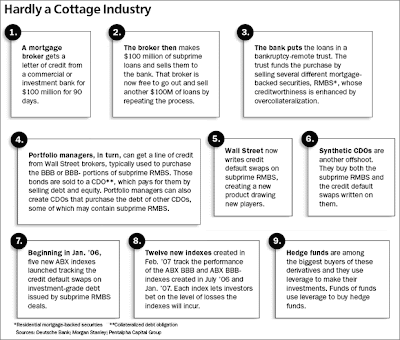“Where’s that money, you silly stupid old fool? Where’s that money? Do you realize what this means? It means bankruptcy and scandal and prison. That’s what it means.”
-George Bailey
The mortgage business has come a long way from the days of “It’s a Wonderful Life.” In the movie, when the residents of Bedford Falls make a run on George’s bank he tells one customer, “I don’t have your money. It’s at Bill’s house and Fred’s house.” This is how a mortgage used to work. The bank took its deposits and loaned them out in the form of mortgages (that’s why they were called “savings and loans.”)
Mortgages no longer work this way. Today’s Barron’s has a great flow chart to show how far we’ve come from the days of Bailey Building & Loan:

To me, what just jumps off the page here is the vast chasm that has developed between the loan originator (the mortgage broker) and the final owner of a mortgage (hedge funds via CDOs). And it’s precisely this disconnect between the originator and the investor that has created the current problems in the market.
Why should a mortgage broker care if a borrower defaults? That’s the investor’s problem. He earns his commision either way. In fact, the more exotic the loan, the bigger his paycheck so his incentive is to find buyers that are likely to default.
Is it any wonder we are now facing a mortgage tsunami? Or that the Federal Housing Authority is now facing its first deficit in its 72-year history? Or that a foreclosure disaster has become a celebrity?
These problems are not going away any time soon. Prominent industry icons and economists are now saying as much.
Angelo Mozillo, CEO of Countrywide, told BusinessWeek that he’s never seen a soft-landing in the housing market and there is “more to come,” in defaults and foreclosures.
Bob Toll, chief of national builder Toll Brothers, told a conference in Vegas that the company’s “prime selling season,” has been, “pretty much a bust,” and that he, “would’ve thought that it [the market for homes] would’ve rebounded by now and I would’ve been dead wrong, and I was.”
David Schulman, a senior economist with the UCLA Anderson Forecast, told the San Francisco Chronicle, “The subprime meltdown is two weeks old. In all likelihood, what’s going on in the subprime market will make things much worse in terms of both volume and prices.”
Steven Roach, Chief Economist at Morgan Stanley, goes even further:
Too much attention is being focused on the narrow story – the extent of any damage to housing and mortgage finance markets. There’s a much bigger story. Yes, the US housing market is currently in a serious recession – even the optimists concede that point. To me, the real debate is about ‘spillovers’ – whether the housing downturn will spread to the rest of the economy. In my view, the lessons of the dot-com shakeout are key in this instance. Seven years ago, the spillover effects played out with a vengeance in the corporate sector, where the dot-com mania had prompted an unsustainable binge in capital spending and hiring. The unwinding of that binge triggered the recession of 2000-01. Today, the spillover effects are likely to be concentrated in the much large consumer sector. And the loss of that pillar of support is perfectly capable of triggering yet another post-bubble recession… The sub-prime carnage is getting all the headlines these days, but in the end, I suspect it will be only a footnote in yet another post-bubble shakeout.
The bottom line is this: it’s going to take much more than Mary’s $2,000 in honeymoon money to save George’s bank from financial calamity this time. While we can only hope for a happy ending I think we have to realize that this movie is now writing itself.
LIV